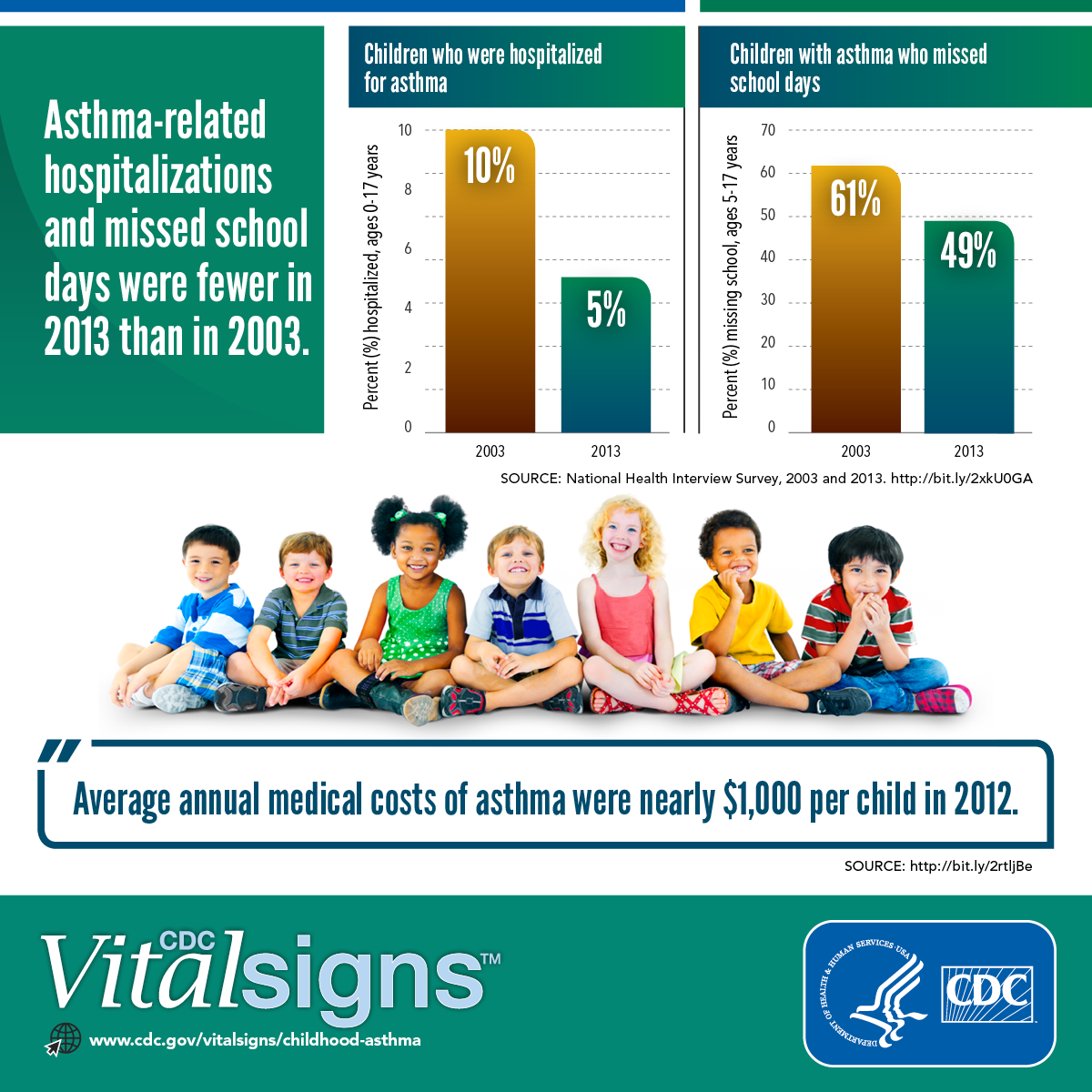Asthma attacks declining among U.S. children
More work needed to continue progress
Press Release
Embargoed Until: Tuesday, February 6, 2018, 1:00 p.m. ET
Contact: Media Relations
(404) 639-3286
Children with asthma in the U.S. are having fewer asthma attacks, missed school days, and visits to the hospital, according to a new Vital Signs report from the U.S. Centers for Disease Control and Prevention.
Today’s report shows that the percentage of children with asthma who experienced one or more asthma attacks in the preceding 12 months declined from 2001 (61.7%) to 2016 (53.7%). Even so, approximately half of children with asthma had one or more asthma attacks in 2016.
“We are making progress – but healthcare providers, parents, caregivers, and schools can do more to help children avoid asthma attacks,” said CDC Acting Director Anne Schuchat, M.D. “Asthma attacks can be terrifying for children and their families. Over the past decade, we’ve identified asthma management actions that work – not alone but in combination. Now we need to scale up these efforts nationwide.”
Asthma is the most common chronic lung disease of childhood, affecting approximately 6 million children in the United States. Although asthma cannot be cured, asthma symptoms can usually be controlled by avoiding or reducing exposure to asthma triggers (allergens and irritants) and by following recommendations for appropriate medical care.
Asthma in U.S. children: Key findings
Today’s report shows that some children are more likely to have asthma than others, including boys, children ages 5-17 years, non-Hispanic black children, children of Puerto Rican descent, and children from low-income families. In 2016, asthma attacks were most common among the youngest children, 4 years old and under.
Other study findings:
- Asthma hospitalizations for children with asthma declined from 9.6 percent in 2003 to only 4.7 percent in 2013.
- The percentage of children who reported asthma-related missed school days also was lower in 2013 than it was in 2003.
- More children with asthma are getting asthma action plans and being taught how to recognize the signs and symptoms of an asthma attack and how to respond quickly.
- Despite this progress, 1 in 6 children with asthma still ends up in the emergency department and about 1 in 20 is hospitalized each year.
Asthma attacks in children: How can doctors, nurses, and other healthcare providers help?
No single strategy is the magic bullet that prevents asthma attacks. But recent evidence from small CDC-funded projects show that a combination of actions can be highly effective:
- Work with children and parents to determine the severity of each child’s asthma, to develop an action plan for each child, and to share the plan with families, schools, and others.
- Teach children and parents how to manage asthma by using control and rescue medicine properly and avoiding asthma triggers such as tobacco smoke, mold, pet dander, and outdoor air pollution.
- Work with community health workers, pharmacists, and other community providers to help ensure that children with asthma receive the services they need.
CDC’s efforts to control asthma
CDC launched the National Asthma Control Program in 1999. Its mission: helping people with asthma breathe easier. The program currently funds partners in 24 states and 1 territory to use data, science, communication, and evaluation to reach this goal.
In addition, CDC promotes proven medical management of asthma, based on CDC’s 6/18 initiative. Such management includes proven actions such as trigger reduction, guidelines-based medical management, and self-management education. The initiative also promotes flu and pneumonia vaccination for all children, improvements in indoor air quality through smoke-free air laws and policies, and partnering with healthcare providers and others to lower asthma costs through improved control.
To read the entire Vital Signs report, visit www.cdc.gov/vitalsigns/childhood-asthma.
About Vital Signs
Vital Signs is a report that appears as part of the CDC’s Morbidity and Mortality Weekly Report. Vital Signs provides the latest data and information on key health indicators.

